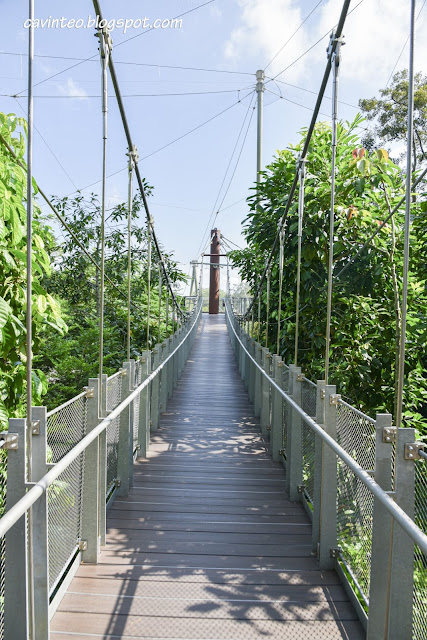The largest and most forested aviaries at Bird Paradise Mandai would be the Rwanda Nyungwe Forest Heart of Africa. As the paradise was planned in the loop format, this would be the first stop if you open for the anti-clockwise loop.
With numerous suspension bridges, there were over 150 matures trees preserved from the original site, before the construction of this attraction! Not that I would have noticed since trees are merely trees to me.
Above was fake though; decorative to stand out and for ease of differentiation from aviary to aviary. If I recall correctly, there were eight aviaries at Bird Paradise Mandai.
Just wondering what else were being built here. This was taken in March last year and a check on Google Map revealed it was the location of Singapore's newest attraction, Rainforest Wild ASIA!
Flamingos underneath us! With a light pink plumage, these are lesser flamingos, smallest amongst the six flamingo species and also the one with the most population at 3 million.
Maybe because Nyungwe Forest Heart of Africa was the most densely forested zone, there were exotic birds that required sophisticated equipment, resulting in the darn huge lens used by the bird photographers.
Towering boulder that could have doubled up as a rock climbing wall but that could have been more suitable for Rainforest Wild ASIA.
I don't know about you but I was so not expecting to see shit splatters! And the appearance of a hideous looking bird, the northern bald ibis!
Other birds spotted.
Bird feeding which I presume was chargeable at a hefty S$8 per portion. Even for Singaporeans, visiting the attractions of Mandai Wildlife Reserve are not cheap. S$8 would be a full meal with drink for me at a hawker centre.
Happier, and cheaper, to see the birds feeding themselves instead.
Guess the food must have been quite good.
If not, the squirrel wouldn't have bothered.
More photographs for reference.
Ground level - the zone had three varying levels to showcase the bird species that can be seen from the top canopy, the mid canopy and the ground level.
I know there would be a specific species for the above.
For the ignorant humans, like me, it's a duck.
Red crested turaco which had a cute nickname.
They are known as feathered mohawks!
Red-winged starling - a bird with shades of black, with the head bearing a grey plumage. Wait, where's the red?! Apparently, you can only see when the bird flies.
Saddlebill storks, and yellow billed storks. For the former, it felt as if the saddlebill storks had their beaks taped with a black tape!
I noticed the motionless bird on top of the building with the entrance / exit, and thought it was a decorative item since I recognized the bird species and assumed it would be too heavy to fly so high.
Turned out the shoebill was real! And despite their size, their average weight was only about 8 kilograms, and the odd looking bird can indeed fly at an altitude "ranging from 500 to 1,000 feet"!
Photos with the dad!
Going out of the zone; measures in place to prevent the birds from escaping the caged aviary! Just wondering if any extreme animal activists would attempt to "help" the birds.
Inside the air-conditioned arena that also functioned as an educational realm. Like the explanation of a peacock feather; do you know it has four components?!
=====
Website















































No comments:
Post a Comment